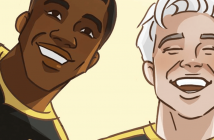Shaking. Jittering. Heart-pounding. Sweating. Dizzy. Pretty much a total mess. That was me every time I had to give an oral report in school. I hated giving presentations so much, in fact, that in eleventh grade science I convinced my presentation group to make an elaborate video about ecosystems (that took an entire weekend to perfect), just so we could avoid the oral report. I also insisted that we make up a whole new ecosystem where lava monsters thrived, but that is a story for another time.
Not-so-fun fact: To this day, whenever I have to give any sort of presentation, I suffer all sorts of insecurities up until the actual event. I question my abilities, even though I know, rationally, that I am qualified and fully prepared. The horrible insecurity leads to even more horrible anxiety—which makes for a horrible time! It turns out that not all problems can be solved with lava monsters.
The only thing that makes all of it a little bit better, which took me a while to figure out, is that I was not (and am not) alone in this. Through all of the ups and downs of having anxiety, books have helped me in a number of ways. I read a lot as a teenager as a means of escape, and now I have come to recognize and appreciate characters that deal with anxiety. I make it a point to seek out books with characters suffering from anxiety and other mental health issues. I particularly appreciate John Green’s cornucopia of struggling characters, and the protagonist with whom I identify most is the amazingly spot on autobiographical character in Allie Brosh’s Hyperbole and a Half.
When it came time for me to write my own book, I knew I wanted to include anxiety and insecurity. You can see it in ‘s Tilly Tailor. Just because Tilly is a genius, she certainly does not know everything and, in , she makes a few questionable decisions. I thought it was important to show that just because you excel intellectually in one arena, it’s OK if you’re not rock solid in other parts of your mind; messing up is OK, no matter what your qualifications are.
The high-school-of-it-all also played a role in my writing Tilly the way she is. Tilly, a brilliant computer scientist, is still a vulnerable teenager who isn’t quite sure how to best handle her anxieties in a school setting. She lashes out in class on page one. She doesn’t know quite how to respond to her romantic feelings. Tilly thinks she should have all the answers, and she has anxiety because she doesn’t have it all figured out.
In the first volume, that Tilly’s specific mental health issues are not addressed by name was on purpose. In my experience, it can take time for a person to put their finger on what’s going on with their brain, and not everyone has access to or is encouraged to get professional help, so I wanted to show a character coping in her own way.
When feeling anxious, Tilly uses a counting trick her father taught her: She stops what she’s doing and counts backward from ten. This “trick” is a stand-in for any number of practices that help people calm down a bit, like deep breathing or meditation. This isn’t to say that this trick ‘fixes’ anything, but it’s what Tilly does to help her get through her day, and at the end of the day, I find that is all anyone can do—that and maybe read a good book about a character with anxiety.



